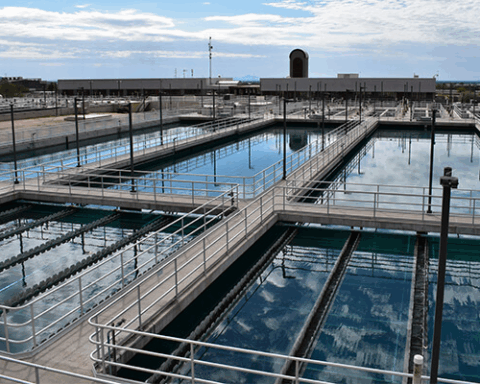New Mexico is looking to reclaim water previously seen as waste for use by industry.
The state is exploring ways to incentivize the treatment and reuse of produced water from the state’s oil and gas industry, as well as deep brackish groundwater, in an effort to ease demand on limited freshwater supplies.
In a feasibility study released earlier this month, the New Mexico Environment Department assessed the potential for using these water sources in manufacturing, energy production and other industrial processes. The study examines both potable and non-potable applications, depending on the specific end use and level of treatment.
Produced water is a byproduct of oil and gas extraction, consisting primarily of naturally occurring saline water mixed with oil and gas remnants. Deep brackish groundwater, found in aquifers more than 2,500 feet below the surface, contains high levels of dissolved solids, making it unsuitable for drinking without treatment.
RELATED: New Mexico unveils 50-year water conservation plan
The push for new water sources comes in response to projected shortages. The state’s 50-Year Water Action Plan estimates a 25% reduction in available water from rivers and aquifers over 50 years, equating to a shortfall of 750,000 acre-feet annually. Simultaneously, water demand is expected to increase by as much as 440,000 acre-feet per year between 2010 and 2060.
This looming water crisis threatens both existing communities and the ability to invest in new industries, including semiconductor manufacturing and hydrogen energy production.
The feasibility study, released by the New Mexico Environment Department, explores the technical and economic viability of treating these water sources for industrial use. The study considers two scenarios: a near-term “closed-loop” model where the water is not discharged back into the environment, and a longer-term scenario allowing for treated water discharge.
Potential industrial applications identified in the study include green hydrogen production, data centers, semiconductor manufacturing, solar panel production, electric vehicle manufacturing, pumped storage hydropower and cement production. The study estimates that green hydrogen production could require between 250,000 and 700,000 gallons of water per day, while semiconductor manufacturing might use 2 to 4 million gallons daily.
Harnessing brackish or produced water is no simple task. Treating produced water, particularly from the Permian Basin, is complex and costly due to high salinity levels and various contaminants. The study estimates treatment costs for Permian Basin produced water could range from $1.00 to $2.14 per barrel, depending on the project scale and duration.
Brackish water is generally less expensive but still costs up to hundreds of millions of dollars upfront.
To incentivize private sector investment, New Mexico is considering using advance purchase commitments, guaranteeing a market for treated water at specified quantities and prices. This approach aims to give assurances to companies making investments in water treatment facilities.
The economic analysis suggests that significant public support may be needed to bridge the gap between treatment costs and what end users are willing to pay. For produced water projects, the estimated net costs range from $13 million to $667 million.
Environmental concerns are also addressed in the study. The “closed-loop” scenario aims to prevent any discharge of treated water or waste streams into the environment. This could limit initial applications to uses like hydrogen production, where the water becomes part of the final product, rather than manufacturing where the water is used in production processes but needs to be disposed of afterwards.
Currently, the New Mexico Environment Department is accepting feedback on its feasibility study through public comment from various stakeholders. This process will end on October 18. The next steps to implement plans for utilizing new water supplies will likely have to go through the state legislature, with a new legislative session set to begin in January of 2025.
Photo courtesy Larry D. Moore













